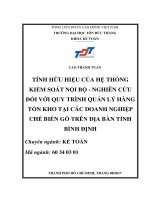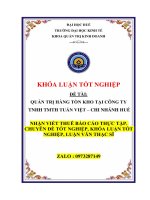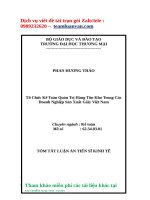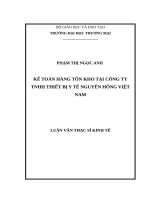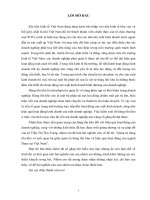inventory and production management in supply chain Giáo trình môn Quản trị nhà kho và tồn kho
Bạn đang xem bản rút gọn của tài liệu. Xem và tải ngay bản đầy đủ của tài liệu tại đây (16.55 MB, 732 trang )
Inventory and
Production Management
in Supply Chains
Fourth Edition
Inventory and
Production Management
in Supply Chains
Fourth Edition
Edward A. Silver
University of Calgary (retired), Alberta, Canada
David F. Pyke
University of San Diego, California, USA
Douglas J. Thomas
Penn State University, Pennsylvania, USA
CRC Press
Taylor & Francis Group
Boca Raton London New York
CRC Press is an imprint of the
Taylor & Francis Croup, an informa business
CRC Press
Taylor & Francis Group
6000 Broken Sound Parkway N W , Suite 300
Boca Raton, FL 33487-2742
© 2017 by Taylor & Francis Group, L L C
CRC Press is an imprint of Taylor & Francis Group, an Informa business
No claim to original U.S. Government works
Printed on acid-free paper
Version Date: 20160830
International Standard Book Number-13:978-1-4665-5861-8 (Hardback)
This book contains information obtained from authentic and highly regarded sources. Reasonable efforts have been made to
publish reliable data and information, but the author and publisher cannot assume responsibility for the validity of all materials
or the consequences of their use. The authors and publishers have attempted to trace the copyright holders of all material repro
duced in this publication and apologize to copyright holders if permission to publish i n this form has not been obtained. If any
copyright material has not been acknowledged please write and let us know so we may rectify i n any future reprint.
Except as permitted under U.S. Copyright Law, no part of this book may be reprinted, reproduced, transmitted, or utilized in any
form by any electronic, mechanical, or other means, now known or hereafter invented, including photocopying, microfilming,
and recording, or in any information storage or retrieval system, without written permission from the publishers.
For permission to photocopy or use material electronically from this work, please access www.copyright.com ( or contact the Copyright Clearance Center, Inc. (CCC), 222 Rosewood Drive, Danvers, M A 01923, 978-750-8400.
C C C is a not-for-profit organization that provides licenses and registration for a variety of users. For organizations that have
been granted a photocopy license by the C C C , a separate system of payment has been arranged.
Trademark Notice: Product or corporate names may be trademarks or registered trademarks, and are used only for identifica
tion and explanation without intent to infringe.
Library of Congress Cataloging-in-Publication Data
Names: Silver, Edward A . (Edward Allen), 1937- author. | Pyke, D. F. (David
F.) author. | Silver, Edward A . (Edward Allen), 1937- Decision systems for
inventory management and production and planning. | Silver, Edward A .
(Edward Allen), 1937- Inventory management and production planning and
scheduling.
Title: Inventory and production management i n supply chains / Edward A .
Silver, David F. Pyke, Douglas J. Thomas.
Description: Fourth Edition. | Boca Raton : Taylor & Francis, 2017. | Revised
edition of Inventory management and production planning and scheduling. |
Includes index.
Identifiers: L C C N 2016022678 | ISBN 9781466558618 (hardback : alk. paper)
Subjects: L C S H : Inventory control—Decision making. | Production
planning—Decision making.
Classification: L C C HD40 .S55 2017 | D D C 658.7/87-dc23
L C record available at />Visit the Taylor & Francis Web site at
and the CRC Press Web site at
Edward A. Silver dedicates this work to Maxine, Michelle, Norman, and Heidi
David F. Pyke dedicates this work to Susan, James, Daniel, and Cory Ad majorem Dei gloriam
Douglas J. Thomas dedicates this work to Traci, Alison, Kate, and Maya
Contents
Preface ............................................................................................................. xix
Acknowledgments .............................................................................................xxiii
Authors ............................................................................................................xxv
SECTION I
THE CONTEXT AND IMPORTANCE OF INVENTORY
MANAGEMENT AND PRODUCTION PLANNING
1 The Importance of Inventory Management and Production Planning and
Scheduling ............................................................................................... 3
1.1 Why Aggregate Inventory Investment Fluctuates: The Business Cycle ................. 7
1.2 Corporate Strategy and the Role of Top Management ..................................... 8
1.3 The Relationship of Finance and Marketing to Inventory Management and
Production Planning and Scheduling .........................................................10
1.3.1 Finance....................................................................................10
1.3.2 Marketing ................................................................................11
1.4 Operations Strategy...............................................................................12
1.4.1 Mission ...................................................................................13
1.4.2 Objectives ................................................................................13
1.4.3 Management Levers ....................................................................15
1.4.4 General Comments.....................................................................16
1.5 Measures of Effectiveness for Inventory Management and Production
Planning and Scheduling Decisions ...........................................................17
1.6 Summary ...........................................................................................18
Problems ....................................................................................................18
References...................................................................................................20
2 Frameworks for Inventory Management and Production Planning and
Scheduling ..............................................................................................23
2.1 The Diversity of Stock-Keeping Units ........................................................23
2.2 The Bounded Rationality of a Human Being ...............................................24
2.3 Decision Aids for Managing Diverse Individual Items ....................................25
2.3.1 Conceptual Aids ........................................................................25
2.3.2 Physical Aids .............................................................................25
2.4 Frameworks for Inventory Management .....................................................26
2.4.1 Functional Classifications of Inventories ...........................................26
2.4.2 The A–B–C Classification as a Basis for Designing Individual Item
Decision Models ........................................................................28
vii
viii
Contents
2.5
A Framework for Production Planning and Scheduling ..................................31
2.5.1 A Key Marketing Concept: The Product Life Cycle .............................31
2.5.2 Different Types of Production Processes ...........................................33
2.5.3 The Product-Process Matrix ..........................................................37
2.6 Costs and Other Important Factors ...........................................................40
2.6.1 Cost Factors..............................................................................40
2.6.2 Other Key Variables ....................................................................44
2.7 Three Types of Modeling Strategies ...........................................................46
2.7.1 Detailed Modeling and Analytic Selection of the Values of a Limited
Number of Decision Variables .......................................................47
2.7.2 Broader-Scope Modeling with Less Optimization ...............................47
2.7.3 Minimization of Inventories with Little Modeling...............................47
2.8 The Art of Modeling .............................................................................47
2.9 Explicit Measurement of Costs.................................................................49
2.10 Implicit Cost Measurement and Exchange Curves .........................................52
2.11 The Phases of a Major Study of an Inventory Management or Production
Planning and Scheduling System ..............................................................53
2.11.1 Consideration ...........................................................................54
2.11.2 Analysis ...................................................................................55
2.11.3 Synthesis ..................................................................................57
2.11.4 Choosing among Alternatives ........................................................57
2.11.5 Control ...................................................................................58
2.11.6 Evaluation ................................................................................58
2.11.7 General Comments.....................................................................58
2.11.8 Transient Effects ........................................................................59
2.11.9 Physical Stock Counts .................................................................59
2.12 Summary ...........................................................................................61
Problems ....................................................................................................61
Appendix 2A: The Lognormal Distribution .........................................................68
References...................................................................................................70
3 Forecasting Models and Techniques ..............................................................73
3.1
3.2
3.3
3.4
3.5
The Components of Time-Series Analysis ...................................................75
The Three Steps Involved in Statistically Forecasting a Time Series ....................77
Some Aggregate Medium-Range Forecasting Methods....................................78
3.3.1 Regression Procedures .................................................................79
Individual-Item, Short-Term Forecasting: Models and Procedures .....................81
3.4.1 The Simple Moving Average .........................................................82
3.4.2 Simple Exponential Smoothing ......................................................84
3.4.3 Exponential Smoothing for a Trend Model .......................................88
3.4.4 Winters Exponential Smoothing Procedure for a Seasonal Model ............92
3.4.5 Selection of Smoothing Constants ................................................ 101
Measuring the Performance of a Forecasting Process .................................... 104
3.5.1 Measures of Forecast Accuracy ..................................................... 105
3.5.2 Estimating the Standard Deviation of Forecast Errors
over a Lead Time ..................................................................... 109
3.5.3 Monitoring Bias....................................................................... 111
Contents
ix
3.5.4 Corrective Actions in Statistical Forecasting..................................... 115
3.5.5 Probability Distributions of Forecast Errors ..................................... 117
3.6 Handling Anomalous Demand .............................................................. 117
3.7 Incorporation of Human Judgment ......................................................... 118
3.7.1 Factors Where Judgment Input Is Needed....................................... 118
3.7.2 Guidelines for the Input and Monitoring of Judgment ....................... 119
3.8 Dealing with Special Classes of Individual Items ......................................... 120
3.8.1 Items with Limited History......................................................... 120
3.8.2 Intermittent and Erratic Demand ................................................. 122
3.8.3 Replacement or Service Parts ....................................................... 123
3.8.4 Terminal Demand .................................................................... 124
3.9 Assessing Forecasting Procedures: Tactics and Strategy.................................. 125
3.9.1 Statistical Accuracy of Forecasts.................................................... 125
3.9.2 Some Issues of a More Strategic Nature .......................................... 126
Problems .................................................................................................. 128
Appendix 3A: Derivations ............................................................................. 135
References................................................................................................. 137
SECTION II
REPLENISHMENT SYSTEMS FOR MANAGING
INDIVIDUAL ITEM INVENTORIES WITHIN A FIRM
4 Order Quantities When Demand Is Approximately Level ................................. 145
4.1
4.2
4.3
4.4
4.5
4.6
4.7
4.8
4.9
Assumptions Leading to the Basic EOQ ................................................... 146
Derivation of the EOQ ........................................................................ 147
4.2.1 Numerical Illustration ............................................................... 151
Sensitivity Analysis.............................................................................. 152
Implementation Aids ........................................................................... 154
4.4.1 Numerical Illustration ............................................................... 155
Quantity Discounts ............................................................................ 155
4.5.1 Numerical Illustrations .............................................................. 158
4.5.2 Item A (An Illustration of Case a of Figure 4.5) ................................ 159
4.5.3 Item B (An Illustration of Case b of Figure 4.5)................................ 159
4.5.4 Item C (An Illustration of Case c of Figure 4.5)................................ 160
Accounting for inflation ....................................................................... 160
4.6.1 Price Established Independent of Ordering Policy ............................. 161
4.6.2 Price Set as a Fixed Fractional Markup on Unit
Variable Cost .......................................................................... 163
Limits on order sizes............................................................................ 164
4.7.1 Maximum Time Supply or Capacity Restriction ............................... 164
4.7.2 Minimum Order Quantity ......................................................... 165
4.7.3 Discrete Units ......................................................................... 165
Finite Replenishment Rate: The Economic Production Quantity .................... 166
Incorporation of Other Factors .............................................................. 168
4.9.1 Nonzero Constant Lead Time That Is Known with
Certainty ............................................................................... 168
4.9.2 Nonzero Payment Period............................................................ 169
4.9.3 Different Types of Carrying Charge .............................................. 169
x
Contents
4.9.4 Multiple Setup Costs: Freight Discounts ........................................ 170
4.9.5 A Special Opportunity to Procure ................................................. 172
4.10 Selection of the Carrying Charge (r), the Fixed Cost per Replenishment (A),
or the Ratio A/r Based on Aggregate Considerations: The Exchange Curve ....... 176
4.10.1 Exchange Curve Illustration ........................................................ 177
4.11 Summary ......................................................................................... 179
Problems .................................................................................................. 179
Appendix 4A: Derivations ............................................................................. 187
References................................................................................................. 193
5 Lot Sizing for Individual Items with Time-Varying Demand ............................. 199
5.1
5.2
5.3
The Complexity of Time-Varying Demand ............................................... 200
The Choice of Approaches .................................................................... 201
General Assumptions and a Numerical Example ......................................... 202
5.3.1 The Assumptions ..................................................................... 202
5.3.2 A Numerical Example ............................................................... 203
5.4 Use of a Fixed EOQ ............................................................................ 204
5.5 The Wagner-Whitin Method: An “Optimal” Solution under an Additional
Assumption ...................................................................................... 205
5.5.1 The Algorithm ........................................................................ 206
5.5.2 Potential Drawbacks of the Algorithm ........................................... 209
5.6 Heuristic Approaches for a Significantly Variable Demand Pattern .................. 212
5.6.1 The Silver–Meal, or Least Period Cost, Heuristic .............................. 212
5.6.2 The EOQ Expressed as a Time Supply (POQ) ................................. 216
5.6.3 Lot-for-Lot ............................................................................. 216
5.6.4 Least Unit Cost ....................................................................... 216
5.6.5 Part-Period Balancing ................................................................ 216
5.6.6 Performance of the Heuristics ...................................................... 218
5.6.7 When to Use Heuristics ............................................................. 219
5.6.8 Sensitivity to Errors in Parameters ................................................ 220
5.6.9 Reducing System Nervousness ..................................................... 221
5.7 Handling of Quantity Discounts ............................................................ 221
5.8 Aggregate Exchange Curves ................................................................... 223
5.9 Summary ......................................................................................... 223
Problems .................................................................................................. 223
Appendix 5A: Dynamic Programming and Linear Programming Formulations ........... 232
References................................................................................................. 233
6 Individual Items with Probabilistic Demand ................................................. 237
6.1
6.2
6.3
6.4
Some Important Issues and Terminology .................................................. 238
6.1.1 Different Definitions of Stock Level .............................................. 238
6.1.2 Backorders versus Lost Sales ........................................................ 239
6.1.3 Three Key Issues to Be Resolved by a Control System under
Probabilistic Demand ................................................................ 239
The Importance of the Item: A, B, and C Classification ................................ 240
Continuous versus Periodic Review ......................................................... 240
The Form of the Inventory Policy: Four Types of Control Systems .................. 241
Contents
xi
6.4.1 Order-Point, Order-Quantity (s, Q) System .................................... 242
6.4.2 Order-Point, Order-Up-to-Level (s, S) System ................................. 242
6.4.3 Periodic-Review, Order-Up-to-Level (R, S) System............................ 243
6.4.4 (R, s, S) System ........................................................................ 244
6.5 Specific Cost and Service Objectives ........................................................ 245
6.5.1 Choosing the Best Approach ....................................................... 246
6.5.2 SSs Established through the Use of a Simple-Minded
Approach ............................................................................... 246
6.5.3 SSs Based on Minimizing Cost .................................................... 248
6.5.4 SSs Based on Customer Service .................................................... 248
6.5.5 SSs Based on Aggregate Considerations .......................................... 250
6.6 Two Examples of Finding the Reorder Point s in a Continuous-Review,
Order-Point, Order-Quantity (s, Q) System .............................................. 250
6.6.1 Protection over the Replenishment Lead Time ................................. 251
6.6.2 An Example Using a Discrete Distribution...................................... 252
6.7 Decision Rules for Continuous-Review, Order-Point, Order-Quantity (s, Q)
Control Systems ................................................................................. 256
6.7.1 Common Assumptions and Notation ............................................ 257
6.7.2 General Approach to Establishing the Value of s ............................... 259
6.7.3 Common Derivation................................................................. 260
6.7.4 Decision Rule for a Specified Safety Factor (k) ................................. 263
6.7.5 Decision Rule for a Specified Cost (B1 ) per Stockout
Occasion................................................................................ 263
6.7.6 Decision Rule for a Specified Fractional Charge (B2 ) per Unit Short ...... 266
6.7.7 Decision Rule for a Specified Fractional Charge (B3 ) per Unit Short
per Unit Time ......................................................................... 268
6.7.8 Decision Rule for a Specified Charge (B4 ) per Customer Line Item
Short .................................................................................... 269
6.7.9 Decision Rule for a Specified Probability (P1 ) of No Stockout per
Replenishment Cycle................................................................. 269
6.7.10 Decision Rule for a Specified Fraction (P2 ) of Demand Satisfied
Directly from Shelf ................................................................... 271
6.7.11 Decision Rule for a Specified Average Time (TBS) between Stockout
Occasions............................................................................... 273
6.7.12 Decision Rule for the Allocation of a TSS to Minimize the ETSOPY ..... 274
6.7.13 Decision Rule for the Allocation of a TSS to Minimize the ETVSPY ..... 274
6.7.14 Nonnormal Lead Time Demand Distributions ................................ 275
6.8 Implied Costs and Performance Measures ................................................. 277
6.9 Decision Rules for Periodic-Review, Order-Up-to-Level (R, S) Control
Systems............................................................................................ 277
6.9.1 The Review Interval (R) ............................................................. 278
6.9.2 The Order-Up-to-Level (S) ......................................................... 278
6.9.3 Common Assumptions and Notation ............................................ 280
6.9.4 Common Derivation................................................................. 280
6.10 Variability in the Replenishment Lead Time Itself ....................................... 282
6.10.1 Approach 1: Use of the Total Demand over the Full
Lead Time .............................................................................. 283
xii
Contents
6.10.2 Approach 2: Use of the Distribution of Demand Rate per Unit Time
Combined with the Lead Time Distribution ................................... 284
6.10.3 Nonnormal Distributions ........................................................... 285
6.11 Exchange Curves Involving SSs for (s, Q) Systems ....................................... 286
6.11.1 Single Item Exchange Curve: Inventory versus Service........................ 287
6.11.2 An Illustration of the Impact of Moving Away from Setting Reorder
Points as Equal Time Supplies ..................................................... 288
6.11.3 Derivation of the SS Exchange Curves ........................................... 290
6.11.4 Composite Exchange Curves ....................................................... 293
6.12 Summary ......................................................................................... 294
Problems .................................................................................................. 295
Appendix 6A: Some Illustrative Derivations and Approximations ............................ 304
References................................................................................................. 312
SECTION III
SPECIAL CLASSES OF ITEMS
7 Managing the Most Important Inventories.................................................... 319
7.1
7.2
7.3
Nature of Class A Items........................................................................ 319
Guidelines for Control of A Items ........................................................... 320
Simultaneous Determination of s and Q for Fast-Moving Items ...................... 322
7.3.1 Decision Rules......................................................................... 323
7.3.2 Cost Penalties.......................................................................... 325
7.3.3 Further Comments ................................................................... 325
7.4 Decision Rules for (s, S) Systems ............................................................ 327
7.4.1 Simple Sequential Determination of s and S .................................... 328
7.4.2 Simultaneous Selection of s and S Using the Undershoot
Distribution............................................................................ 328
7.4.3 Comparison of the Methods........................................................ 331
7.5 Decision Rules for (R, s, S) Systems ......................................................... 332
7.5.1 Decision Rule for a Specified Fractional Charge (B3 )
per Unit Short at the End of Each Period........................................ 332
7.5.2 Decision Rule for a Specified Fraction (P2 ) of Demand Satisfied
Directly from Shelf ................................................................... 334
7.6 Coping with Nonstationary Demand....................................................... 337
7.7 Comments on Multiple Sources of Supply and Expediting ........................... 339
7.8 Summary ......................................................................................... 341
Problems .................................................................................................. 341
Appendix 7A: Simultaneous Solutions for Two Control Parameters.......................... 345
References................................................................................................. 346
8 Managing Slow-Moving and Low-Value (Class C) Inventories ........................... 351
8.1
8.2
Order-Point, Order-Quantity (s, Q) Systems for Slow-Moving A Items ............ 351
8.1.1 B2 Cost Measure for Very-Slow-Moving, Expensive
Items (Q = 1) ......................................................................... 353
8.1.2 Case of Q ≥ 1 and a B1 Cost Structure.......................................... 356
8.1.3 Simultaneous Determination of s and Q for Slow-Moving Items........... 356
Controlling the Inventories of Intermittent Demand Items............................ 357
Contents
xiii
8.3
8.4
Nature of C Items............................................................................... 358
Control of C Items Having Steady Demand .............................................. 359
8.4.1 Inventory Records .................................................................... 359
8.4.2 Selecting the Reorder Quantity (or Reorder Interval) ......................... 359
8.4.3 Selecting the Reorder Point (or Order-up-to Level) ........................... 360
8.4.4 Two-Bin System Revisited .......................................................... 361
8.4.5 Simple Form of the (R, S) System................................................. 362
8.4.6 Grouping of Items .................................................................... 363
8.5 Control of Items with Declining Demand Patterns...................................... 363
8.5.1 Establishing the Timing and Sizes of Replenishments under
Deterministic Demand .............................................................. 363
8.5.2 Sizing of the Final Replenishment under Probabilistic Demand ............ 364
8.6 Reducing Excess Inventories .................................................................. 365
8.6.1 Review of the Distribution by Value .............................................. 366
8.6.2 Rule for the Disposal Decision..................................................... 368
8.6.3 Options for Disposing of Excess Stock ........................................... 370
8.7 Stocking versus Not Stocking an Item ...................................................... 371
8.7.1 Relevant Factors....................................................................... 371
8.7.2 Simple Decision Rule ................................................................ 372
8.7.3 Some Extensions ...................................................................... 373
8.8 Summary ......................................................................................... 374
Problems .................................................................................................. 374
Appendix 8A: Poisson Distribution and Some Derivations..................................... 379
References................................................................................................. 384
9 Style Goods and Perishable Items ............................................................... 387
9.1
9.2
9.3
9.4
9.5
9.6
9.7
Style Goods Problem ........................................................................... 388
Simplest Case: Unconstrained, Single-Item, Newsvendor Problem................... 389
9.2.1 Determination of the Order Quantity by Marginal Analysis ................ 389
9.2.2 An Equivalent Result Obtained through Profit
Maximization .......................................................................... 391
9.2.3 Case of Normally Distributed Demand .......................................... 392
9.2.4 Case of a Fixed Charge to Place the Order ...................................... 394
9.2.5 Case of Discrete Demand ........................................................... 395
Single-Period, Constrained, Multi-Item Situation ....................................... 397
9.3.1 Numerical Illustration ............................................................... 399
Postponed Product Differentiation .......................................................... 401
9.4.1 Value of Delayed Financial Commitment ....................................... 402
9.4.2 Value of Flexibility.................................................................... 403
More than One Period in Which to Prepare for the Selling Season................... 408
Multiperiod Newsvendor Problem .......................................................... 408
Other Issues Relevant to the Control of Style Goods .................................... 409
9.7.1 Updating of Forecasts ................................................................ 409
9.7.2 Reorders and Markdowns ........................................................... 410
9.7.3 Reserving Capacity Ahead of Time ............................................... 411
9.7.4 Inventory Policies for Common Components .................................. 411
9.7.5 Other Research ........................................................................ 412
xiv
Contents
9.8 Inventory Control of Perishable Items ...................................................... 413
9.9 Summary ......................................................................................... 414
Problems .................................................................................................. 414
Appendix 9A: Derivations ............................................................................. 422
References................................................................................................. 427
SECTION IV MANAGING INVENTORY ACROSS MULTIPLE
LOCATIONS AND MULTIPLE FIRMS
10 Coordinated Replenishments at a Single Stocking Point................................... 437
10.1 Advantages and Disadvantages of Coordination.......................................... 438
10.2 Deterministic Case: Selection of Replenishment Quantities in a Family
of Items ........................................................................................... 439
10.2.1 Assumptions ........................................................................... 439
10.2.2 Decision Rule.......................................................................... 440
10.2.3 A Bound on the Cost Penalty of the Heuristic Solution ...................... 443
10.3 Deterministic Case with Group Discounts ................................................ 443
10.3.1 Numerical Illustration ............................................................... 446
10.4 Case of Probabilistic Demand and No Quantity Discounts............................ 447
10.4.1 (S, c, s), or Can-Order, Systems .................................................... 448
10.4.2 Periodic Review System.............................................................. 448
10.5 Probabilistic Demand and Quantity Discounts........................................... 451
10.5.1 A Full Truckload Application ...................................................... 453
10.5.2 Numerical Illustration ............................................................... 454
10.6 Production Environment ...................................................................... 456
10.6.1 Case of Constant Demand and Capacity: Economic Lot
Scheduling Problem .................................................................. 456
10.6.2 Case of Time-Varying Demand and Capacity: Capacitated
Lot Sizing............................................................................... 461
10.6.3 Probabilistic Demand: The Stochastic Economic
Lot Scheduling Problem............................................................. 463
10.7 Shipping Consolidation ....................................................................... 464
10.8 Summary ......................................................................................... 465
Problems .................................................................................................. 465
Appendix 10A: Derivation of Results in Section 10.2 ........................................... 474
References................................................................................................. 477
11 Multiechelon Inventory Management .......................................................... 487
11.1 Multiechelon Inventory Management ...................................................... 487
11.2 Structure and Coordination .................................................................. 489
11.3 Deterministic Demand ........................................................................ 491
11.3.1 Sequential Stocking Points with Level Demand ................................ 491
11.3.2 Other Results for the Case of Level Demand ................................... 495
11.3.3 Multiechelon Stocking Points with Time-Varying Demand ................. 496
11.4 Probabilistic Demand .......................................................................... 498
11.4.1 Base Stock Control System ......................................................... 501
11.4.2 Serial Situation ........................................................................ 503
Contents
xv
11.4.3 Arborescent Situation ................................................................ 506
11.5 Remanufacturing and Product Recovery ................................................... 513
11.5.1 Multiechelon Situation with Probabilistic Usage and
One-for-One Ordering .............................................................. 515
11.5.2 Some Extensions of the Multiechelon Repair Situation....................... 520
11.5.3 Some Insights and Results for the More General Context of
Remanufacturing and Product Recovery......................................... 521
11.6 Additional Insights ............................................................................. 523
11.6.1 Economic Incentives to Centralize Stocks ....................................... 523
11.6.2 Where to Deploy Stock.............................................................. 525
11.6.3 Lateral Transshipments .............................................................. 526
11.7 Summary ......................................................................................... 526
Problems .................................................................................................. 526
Appendix 11A: Derivation of the Logic for Computing the Best Replenishment
Quantities in a Deterministic, Two-Stage Process .......................... 530
References................................................................................................. 531
12 Coordinating Inventory Management in the Supply Chain ............................... 543
12.1 Information Distortion in a Supply Chain ................................................ 544
12.2 Collaboration and Information Sharing .................................................... 546
12.2.1 Sales and Operations Planning..................................................... 546
12.2.2 Collaborative Forecasting ........................................................... 547
12.3 Vendor-Managed Inventory .................................................................. 548
12.4 Aligning Incentives ............................................................................. 548
12.4.1 Wholesale Price Contract ........................................................... 549
12.4.2 Buyback Contract .................................................................... 551
12.4.3 Revenue-Sharing Contract .......................................................... 553
12.4.4 Service-Level Agreements ........................................................... 554
12.4.5 Challenges Implementing Coordinating Agreements ......................... 554
12.5 Summary ......................................................................................... 555
Problems .................................................................................................. 555
References................................................................................................. 556
SECTION V PRODUCTION MANAGEMENT
13 An Overall Framework for Production Planning and Scheduling ....................... 561
13.1 Characteristics of Different Production Processes ........................................ 561
13.2 A Framework for Production Decision Making .......................................... 564
13.2.1 A Review of Anthony’s Hierarchy of Managerial Decisions .................. 564
13.2.2 Integration at the Operational Level .............................................. 565
13.2.3 The Framework ....................................................................... 565
13.3 Options in Dealing with the Hierarchy of Decisions .................................... 571
13.3.1 Monolithic Modeling Approach ................................................... 571
13.3.2 Implicit Hierarchical Planning ..................................................... 572
13.3.3 Explicit Hierarchical Planning ..................................................... 572
13.3.4 The Hax–Meal Hierarchical Planning System .................................. 573
13.4 Summary ......................................................................................... 576
xvi
Contents
Problems .................................................................................................. 577
References................................................................................................. 577
14 Medium-Range Aggregate Production Planning............................................. 581
14.1 The Aggregate Planning Problem............................................................ 581
14.2 The Costs Involved ............................................................................. 585
14.2.1 Costs of Regular-Time Production ................................................ 585
14.2.2 Overtime Costs ....................................................................... 587
14.2.3 Costs of Changing the Production Rate ......................................... 587
14.2.4 Inventory Associated Costs ......................................................... 588
14.2.5 Costs of Insufficient Capacity in the Short Run ................................ 589
14.3 The Planning Horizon ......................................................................... 590
14.4 Two Pure Strategies: Level and Chase....................................................... 591
14.5 Feasible Solution Methods .................................................................... 592
14.5.1 General Comments................................................................... 592
14.5.2 An Example of a Graphic–Tabular Method ..................................... 593
14.6 Linear Programming Models ................................................................. 599
14.6.1 Strengths and Weaknesses........................................................... 601
14.6.2 The Inclusion of Integer Variables in LP Formulations ....................... 602
14.6.3 The Land Algorithm ................................................................. 603
14.7 Simulation Search Procedures ................................................................ 603
14.8 Modeling the Behavior of Managers ........................................................ 605
14.8.1 Management Coefficients Models ................................................. 605
14.8.2 Manpower Decision Framework................................................... 607
14.9 Planning for Adjustments Recognizing Uncertainty ..................................... 607
14.9.1 The Production-Switching Heuristic ............................................. 608
14.10 Summary ......................................................................................... 609
Problems .................................................................................................. 610
References................................................................................................. 617
15 Material Requirements Planning and Its Extensions........................................ 621
15.1 The Complexity of Multistage Assembly Manufacturing............................... 622
15.2 The Weaknesses of Traditional Replenishment Systems in a
Manufacturing Setting ......................................................................... 623
15.3 Closed-Loop MRP.............................................................................. 624
15.4 Material Requirements Planning............................................................. 626
15.4.1 Some Important Terminology...................................................... 626
15.4.2 Information Required for MRP ................................................... 630
15.4.3 The General Approach of MRP ................................................... 630
15.4.4 A Numerical Illustration of the MRP Procedure ............................... 633
15.4.5 The Material Requirements Plan and Its Uses .................................. 639
15.4.6 Low-Value, Common-Usage Items................................................ 639
15.4.7 Pegging.................................................................................. 639
15.4.8 Handling Requirements Updates .................................................. 640
15.4.9 Coping with Uncertainty in MRP ................................................ 641
15.5 Capacity Requirements Planning ............................................................ 642
15.6 Distribution Requirements Planning ....................................................... 644
Contents
xvii
15.7 Weaknesses of MRP ............................................................................ 645
15.8 ERP Systems ..................................................................................... 647
15.8.1 Enhancements to ERP Systems .................................................... 649
15.9 Summary ......................................................................................... 650
Problems .................................................................................................. 650
References................................................................................................. 656
16 Just-in-Time, Optimized Production Technology and Short-Range Production
Scheduling ............................................................................................ 661
16.1 Production Planning and Scheduling in Repetitive Situations: Just-in-Time ....... 662
16.1.1 Philosophy of JIT..................................................................... 662
16.1.2 Kanban Control System ............................................................. 664
16.1.3 Benefits and Weaknesses of JIT .................................................... 669
16.2 Planning and Scheduling in Situations with Bottlenecks: Optimized
Production Technology ........................................................................ 671
16.2.1 Philosophy of OPT................................................................... 671
16.2.2 Drum-Buffer-Rope Scheduling .................................................... 676
16.2.3 A Related System: CONWIP ...................................................... 677
16.2.4 Benefits and Weaknesses of OPT.................................................. 678
16.3 Short-Range Production Scheduling ........................................................ 679
16.3.1 Issues in Short-Term Scheduling .................................................. 680
16.3.2 Techniques for Short-Term Scheduling .......................................... 684
16.3.3 Deterministic Scheduling of a Single Machine: Priority
Sequencing Rules ..................................................................... 688
16.3.4 General Job Shop Scheduling ...................................................... 692
16.4 Summary ......................................................................................... 699
Problems .................................................................................................. 699
Appendix 16A: Proof that SPT Minimizes Total Flowtime..................................... 703
References................................................................................................. 704
17 Summary .............................................................................................. 713
17.1 Operations Strategy............................................................................. 713
17.2 Changing the Givens ........................................................................... 714
17.3 Future Developments .......................................................................... 715
Appendix I: Elements of Lagrangian Optimization ................................................ 717
Appendix II: The Normal Probability Distribution ................................................ 723
Appendix III: Approximations and Excel Functions ............................................... 743
Author Index ................................................................................................ 749
Subject Index ................................................................................................ 767
Preface
Dramatic advances in information and communication technologies have allowed firms to be more
closely connected to a broad and global network of suppliers providing components, finished
goods, and services. Customers want their products quickly and reliably, even if they are coming
from another continent; and they are often willing to look for other suppliers if products are frequently delivered late. As a result, inventory management and production planning and scheduling
have become even more vital to competitive success.
Inventory management and production planning and scheduling have been studied in considerable depth from a theoretical perspective. Yet, the application of these theories is still somewhat
limited in practice. A major gap has existed between the theoretical solutions, on the one hand,
and the real-world problems, on the other.
Our primary objective in the first three editions of the book was to bridge this gap through
the development of operational inventory management and production planning decision systems
that would allow management to capitalize on readily implementable improvements to current
practices. Extensive feedback from both academicians and practitioners has been very gratifying in
this regard. Our primary objective is unchanged in this revised edition. In the third edition, we
placed an emphasis on how computing tools, such as spreadsheets, can be used to apply the models
presented in this book. While sophisticated supply chain planning software is now widely available,
we still find that spreadsheets are ubiquitous in practice. As such, we have retained and expanded
content on the spreadsheet application of the models in this book.
Advances in information technology have made it easier for firms to exchange information
with their trading partners. Indeed, much of the academic and practitioner literature on supply
chain management has focused on how firms can collaborate and share information to reduce costs
in their shared supply chains. Generally speaking, these initiatives have had a positive economic
impact. As discussed in Chapter 1, inventory as a percent of sales, and logistics costs as a percent of
gross domestic product, have been consistently declining. Our opinion is that these savings are just
the tip of the iceberg. It is now commonplace for an employee in an inventory or manufacturing
planning role to (a) have powerful tools on their personal computer, and (b) have access to demand
and supply-related data. This means it has never been easier to implement rigorous planning models such as those presented in this book. This is not to say that it is easy, just easier than before.
There are new challenges to planning in modern supply chains where operations are distributed
throughout the globe and across many companies. As such, we have included new material in this
edition addressing how to collaborate from a planning perspective across departments within an
organization and with external trading partners.
As with all editions of this book, we have drawn on the writings of literally hundreds of
scholars who have extended theory and who have implemented theory in practice. We have also
incorporated many helpful suggestions from our colleagues.
xix
xx
Preface
Where appropriate, new modeling approaches and an updated discussion of the literature have
been added throughout the book. Here, we briefly highlight some of the major changes in this
edition.
1. The first two chapters from the previous edition have been updated and streamlined into
one chapter. This chapter highlights recent macroeconomic trends in inventory and logistics
costs, and includes a discussion of how these changes affect operations and corporate strategy.
2. Chapters from the previous edition on Just-in-Time and short-range production scheduling
have been updated and consolidated into a single chapter.
3. A new chapter on coordinating inventory management in the supply chain has been added.
This chapter addresses collaboration and coordination within a firm through processes such
as sales and operations planning, as well as external collaboration through initiatives such
as collaborative planning, forecasting and replenishment, and vendor managed inventory.
Contractual approaches for coordinating inventory decisions between firms are also covered.
4. The treatment of how to manage inventory for items with low-volume, erratic, or nonstationary demand has been expanded. This includes the addition of derivations and
spreadsheet applications for the Poisson distribution.
5. The discussion of supply chain planning software tools including Enterprise Resource
Planning (ERP) systems and advanced planning tools has been updated and expanded.
6. The treatment of managing multiple items through the use of composite exchange curves has
been expanded. To accompany this material, data sets and associated problems are available
as supplemental material. These data sets provide students with the opportunity to apply the
concepts in the book to realistic, practical settings.
We have continued to attempt to provide a deep and rigorous treatment of the material without
presenting complicated mathematics in the main text. Additional derivations have been added
in this edition, but this content generally appears in an appendix. We have chosen this style of
presentation deliberately so that sufficient material of interest is made available to the analytically
inclined reader, while at the same time providing a meaningful text for a less analytically oriented
audience.
Section I of the book presents a discussion on inventory management and production planning
decisions as important components of total business strategy. The topics covered include operations
strategy, the diverse nature of inventories, the complexity of production/inventory decision making,
cost measurement, and an introduction to the important concept of exchange curves. A separate
chapter is devoted to the determination of forecasting strategy and the selection of forecasting
methods.
Section II is concerned with traditional decision systems for the inventory control of individual
items. The use of approximate decision rules, based on sound logic, permits realistic treatment of
time-varying (e.g., seasonal) demand, probabilistic demand, and the many different attitudes of
management toward costing the risk of insufficient capacity in the short run.
Section III deals with special classes of items, including the most important (Class A) and the
large group of low-activity items (Class C). Also discussed are procedures for dealing with items
that can be maintained in inventory for only relatively short periods of time—for example, style
goods and perishable items (the newsvendor problem).
Section IV addresses three types of coordination of groups of items primarily in nonproduction contexts. First, there is the situation of a family of items, at a single stocking location, that
share a common supplier, a common mode of transport, or common production equipment. The
Preface
xxi
second type of coordination is where a single firm is managing inventory across several of their
locations in a multiechelon network. For such a setting, replenishment requests from one stocking point become part of the demand at another location. The third context is where items are
managed across a network where locations in the network are managed by different firms. This
setting requires new approaches to share information and align incentives among trading partners
to effectively manage inventory throughout the supply chain.
Section V is concerned with decision making in a production environment. A general
framework for such decision making is presented. It covers aggregate production planning, material requirements planning, enterprise resource planning systems, JIT, OPT R , and short-range
production scheduling.
This book should be of interest to faculty and students in programs of business administration, industrial/systems engineering, and management sciences/operations research. Although the
presentation is geared to a foundational course in production planning, scheduling, and inventory management, the inclusion of extensive references permits its use in advanced elective courses and as a
starting point for research activities. At the same time, the book should continue to have a broad
appeal to practicing analysts and managers.
Acknowledgments
The manuscript, as is often the case, had its origin in the teaching notes used by the authors for
several years in courses they taught at the Amos Tuck School at Dartmouth College, The University
of Auckland, Boston University, The University of Calgary, The University of Canterbury (New
Zealand), The Smeal College of Business at Penn State, The Swiss Federal Polytechnique Institute,
and the University of Waterloo. A large number of students (including many part-time students
holding employment in industry) have provided excellent critiques.
A significant portion of the book has developed out of research supported by the Natural Sciences and Engineering Research Council of Canada, the Defence Research Board of Canada, and
the Ford Foundation. Support was also provided by the Tuck School, the School of Business at the
University of San Diego, and the Center for Supply Chain Research in the Smeal College of Business. The authors gratefully acknowledge all the aforementioned support. Numerous consulting
assignments involving the authors have also had substantial influence on the contents of the book.
Special mention must be made of two authorities in the field who, early in our careers, encouraged us to work in the general area of inventory and production management—namely, Robert
G. Brown, as a colleague at Arthur D. Little, Inc., and Morris A. Cohen, as a PhD advisor at the
Wharton School, University of Pennsylvania. Also, we wish to express our sincere thanks to Rein
Peterson for his contributions as coauthor of earlier editions of this book.
Many of our professional colleagues have provided helpful comments concerning our research
papers, the earlier editions of the book, and the drafts of the current edition. In addition, numerous
other colleagues have made available drafts of papers in the more advanced topic areas. Many of the
publications of these contributors are referenced in this book. We appreciate all these important
contributions. The list of all these colleagues would be too long to include, but we do wish to specifically mention Daniel Costa (Nestle S.A.), Robert Lamarre (Gestion Conseil Robert Lamarre), and
David Robb (University of Auckland).
Finally, on such a major task, a special word of thanks is necessary for those individuals who
have edited and proofread the many drafts of the manuscript. While a student at Penn State, Jimmy
Chen (Bucknell University) carefully reviewed the manuscript, providing very helpful suggestions
and edits. Lauren Bechtel, Sharon Cox, Rachel Gimuriman, and Denis Harp were extremely
helpful in supporting editing and formatting of tables and figures.
Edward A. Silver
David F. Pyke
Douglas J. Thomas
xxiii

